|
|
|
Sort Order |
|
|
|
Items / Page
|
|
|
|
|
|
|
| Srl | Item |
| 1 |
ID:
160839


|
|
|
|
|
| Summary/Abstract |
In the reform era, management of information by the Chinese Communist Party has been continuously moving away from explicit, crude tactics of the past toward more subtle and orderly mechanisms of the present. This study examines one facet of this transformation in the online sphere: digital persuasion. Drawing on three emerging trends in online persuasion, including official digital revamping of state media, expansion of government Weibo, and official promotion of patriotic bloggers, the authors explain how online persuasion is taking on an increasingly participatory form under President Xi. Specifically, the conceptualization of ‘authoritarian participatory persuasion 2.0’ includes direct co-production of persuasion, with netizens called to repost, share and create content, as well as the indirect participation, whereby netizens are invited to partake in the life of the top leader, Xi Jinping, and to consume exclusive practical tips provided by the state. The participatory digital persuasion, whereas intended to facilitate public complicity with the regime, has also opened up spaces for satire and ‘incivility’ unmasking and challenging the state’s covert propaganda practices.
|
|
|
|
|
|
|
|
|
|
|
|
|
|
|
|
| 2 |
ID:
160834
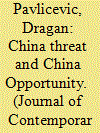

|
|
|
|
|
| Summary/Abstract |
Development of ‘16 + 1’ framework substantially depends on how Central and Eastern European countries understand their fast-evolving relationship with China. This article investigates and analyses related perceptions and discusses their implications for ‘16 + 1’. Focusing on the Sino-Serbian relationship, the study reveals that the understanding of China and its growing involvement in the region oscillates between the extremes, yet that both positive and negative evaluations are not supported by the available empirical evidence and informed by a proper understanding of the context within which the relationship takes place. This is likely to result in a sense of disillusionment, as well as heightened concerns about the relationship with China, casting shadow over the prospects of the China-CEE relations.
|
|
|
|
|
|
|
|
|
|
|
|
|
|
|
|
| 3 |
ID:
160831
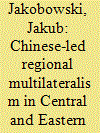

|
|
|
|
|
| Summary/Abstract |
This article examines the network of Chinese-led regional platforms, established throughout the developing world in the twenty-first century. It seeks to identify the common features of Chinese-led regional multilateralism: its normative basis, institutionalization patterns and the scope of cooperation. A comparative study of three selected platforms established in Central and Eastern Europe (16 + 1), Africa (FOCAC), and Latin America (CCF) is provided. These comprehensive dialogue mechanisms are based on Chinese-backed norms of non-binding agreements, voluntarism and consensus, derived from the tradition of South–South cooperation. This translates into a flexible and loose institutional structure that enables China to combine multilateral and bilateral approaches, creating a highly adaptable blueprint for managing foreign relations on a regional scale. The article evaluates the outcomes of the Chinese-led regional model and discusses the implications of the findings for the understanding of China’s evolving foreign policy.
|
|
|
|
|
|
|
|
|
|
|
|
|
|
|
|
| 4 |
ID:
160833
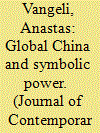

|
|
|
|
|
| Summary/Abstract |
This article analyzes the practice and effects of China’s new foreign policy by applying a research framework inspired by Bourdieu(s)ian international political sociology centered on the notion of symbolic power. To analyze China’s symbolic power in action, the article uses the case of the cooperation between China and the 16 countries of Central, East, and Southeast Europe, dubbed ‘16 + 1’. It discusses how, through symbolic domination that rests on concealing the true meaning of the cooperation, China contributes to changes in the established notions on boundaries, historical legacies, and development paradigms in the region of Central and Eastern Europe (CEE).
|
|
|
|
|
|
|
|
|
|
|
|
|
|
|
|
| 5 |
ID:
160838
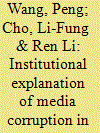

|
|
|
|
|
| Summary/Abstract |
This article develops an institutional explanation of news extortion—an important form of media corruption—by incorporating the connection between macro-, meso-, and micro-level factors into analysis. It argues that China’s uneven media reform and the rise of new media have created a conflict-riven and highly competitive environment that demands traditional media organizations to adopt the strategy of decoupling, namely the creation and maintenance of gaps between formal policy and actual organizational practice, to ensure organizational survival. An in-depth case analysis of the 21st Century Business Herald, a leading business newspaper whose website was ultimately shutdown by Chinese authorities due to extortion allegations, offers insights into how media organizations respond to an increasingly hostile environment by adopting the policy-practice decoupling strategy: distorting formal policies (e.g. the prohibition of paid news and the maintenance of a ‘firewall’ between editorial and advertising) in daily practice. Such a strategy, although furthering internal organizational efficiency, results in a prevalence of journalistic misconduct including ‘paid-for news’ and news extortion.
|
|
|
|
|
|
|
|
|
|
|
|
|
|
|
|
| 6 |
ID:
160836


|
|
|
|
|
| Summary/Abstract |
While major arenas of Sino-Japanese struggle are maritime security affairs and political leadership in managing regional affairs, infrastructure development is emerging as a new source of rivalry. Given this new trend, this article highlights rivalry in the provision of regional institutions and programs to sustain infrastructure development and the winning of the Jakarta–Bandung high-speed railway project in Indonesia. It argues that in committing to infrastructure development, China and Japan were required to pay due attention to close connections with existing multilateral development banks and responses to the needs of a target government. Moreover, it contends that both states regarded commitments to infrastructure development as crucial vehicles to enhance political leverage and means to sustain the national economy and diffuse specific ideals for development.
|
|
|
|
|
|
|
|
|
|
|
|
|
|
|
|
| 7 |
ID:
160843
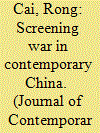

|
|
|
|
|
| Summary/Abstract |
War has been a prominent theme in cultural productions of the People’s Republic of China (PRC). Repeated representations by the socialist cinema and beyond have produced a revolutionary imagination of war that glorifies death and sacrifice, subsuming individual experience of pain and loss under the discourse of the Communist nation-building. This article focuses on a revisionist reading of the revolutionary imagination of war in Feng Xiaogang’s 2007 New Year Film The Assembly. It has a dual focus. First, it discusses the genre practice of war film in the mainland cinema and the relation among war film, representation of violence, heroism, and nation building. Then it examines how Feng’s visceral depiction of combat redirects the focus from the master narrative of nation-building to the individual. Second, focusing on the main character’s quest for honor for his fallen soldiers, this article explores how the film critiques the power structure of the revolutionary honor system that valorizes the revolutionary imagination of war. Ultimately, the discussion proves that the film is as much a confirmation of the revolutionary nation-building as a poignant critique and subversion of the official vision of honor and history.
|
|
|
|
|
|
|
|
|
|
|
|
|
|
|
|
| 8 |
ID:
160835
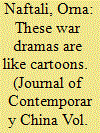

|
|
|
|
|
| Summary/Abstract |
The growing prevalence of foreign media consumption, including from Japan, has received considerable notice in recent work on PRC youth culture. To date, however, few studies have considered how youth of different social backgrounds perceive their consumption of Japanese popular culture in the context of the Party-state’s ‘patriotic education’ campaign waged in schools and in the mass media. Studies have also overlooked how rural and urban youth in China juxtapose the images and themes conveyed in the Japanese media that they consume with school and domestic media messages. Drawing on interviews with middle school students in Shanghai and Henan, the present study addresses these issues. It finds that while a majority of youths from different backgrounds express animosity toward Japan, they separate these feelings from their passion for Japanese popular culture. In some cases, consumption of Japanese media also allows teenagers to feel that they ‘know’—or even appreciate—the other country better. Amid the anti-Japanese messages currently circulating in PRC schools and domestic media, consumption of Japanese popular culture manifests a form of ‘expressive individualism’ among teenagers, who creatively construct their own notions of patriotism, national memory, and Sino–Japanese relations.
|
|
|
|
|
|
|
|
|
|
|
|
|
|
|
|
| 9 |
ID:
160837


|
|
|
|
|
| Summary/Abstract |
By analyzing public records of Chinese officials charged under China’s current national anti-corruption campaign, this study is the first to reveal patterns of corruption among Chinese officials at all ranks and in diverse occupations. The study sheds critical light on the networks through which corrupt officials are connected, the extent to which they have engaged in corrupt activities and influenced others, and the level of government and occupation the main perpetrators occupy. Drawing upon public information and court indictments, the author uses social network analysis as a tool to expose these relationships and the network of corrupt activities. In addition to identifying important individuals involved in corrupt practices, this article uncovers patterns of corruption and reveals the structure of corruption networks among Chinese officials.
|
|
|
|
|
|
|
|
|
|
|
|
|
|
|
|
|
|
|
|
|